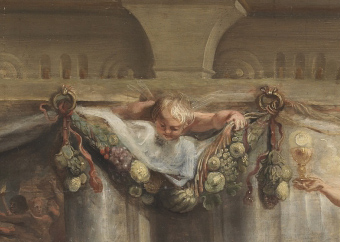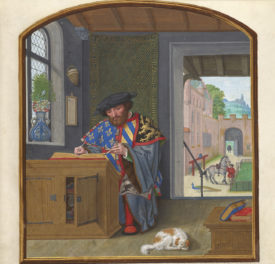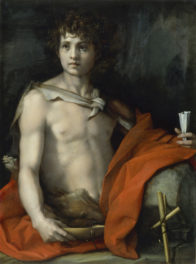From the 17,000-year-old cave paintings at Lascaux to that iconic ‘80s Trapper Keeper, humans have been making art about horses longer than we have been riding them.
Art featuring horses is so prominent in the Getty’s collections that this is the third Iris article on the subject and there are still plenty of noble steeds with luscious manes to admire.
According to paintings curator Anne Woollett, “artists have been drawn to horses for the challenges of representing complex figures in space and in motion. They have also been drawn to the challenge of articulating the character of the equine subject and that of his human companions—such as nobility of spirit, virtue, fortitude, or companionship.”
Here are just a few examples of the many horses in the Getty’s stables.
A Dappled Gray Stallion Tethered in a Landscape

A Dappled Gray Stallion Tethered in a Landscape, about 1584–1587, Prague School. Watercolor and gouache, heightened with silver and gold, within gold framing lines, on vellum, 7 11/16 × 10 13/16 in. The J. Paul Getty Museum, 2013.57. Digital image courtesy of Getty’s Open Content Program
In this meticulously executed drawing, a light gray dappled stallion stands tethered to a tree stump in a verdant landscape. The well-groomed horse appears calm yet aware of the viewer as if posing for its portrait. Eye-catching details abound in this drawing such as the animal’s direct gaze, its textured mane and tail, the carefully tied knot of the bridle, the dappled pattern on its hindquarters, the small nails embedded in its shoes. And in the landscape: white clouds, undulating green hills, and a winding stream, a tree stump, and roads.
It is quite likely that the same aristocratic person who once proudly owned the stallion also commissioned this drawing. Two similar depictions of magnificent horses in other collections appear to be created by the same as-yet-unknown artist, presumably for the same patron. Small stitching holes in the sheets of paper suggest that they were once bound together in an album. The medium used, gouache on vellum—in addition to the fine painting style—reflects a tradition of manuscript illumination.
Evidence points to the possibility that the drawings’ patron was Moravian Baron Jan Šembera of Bučovice and that the highly accomplished artist was associated with the court of Holy Roman Emperor Rudolf II in Prague. The horse itself offers a hint, resembling the Lipizzan breed prized by Renaissance aristocrats associated with the imperial Habsburg court.
Rearing Horse

Rearing Horse, 1605–1610, Adriaen de Vries. Bronze, 19 1/2 × 21 1/2 in. The J. Paul Getty Museum, 86.SB.488. Digital image courtesy of Getty’s Open Content Program
This rearing horse’s two hind legs, upon which he balances his powerful bulk, serve as the sole support for the body of this large animal. Pawing the air and tilting his head to the left, the horse electrifies the space around him. The sculptor Adriaen de Vries further suggested the animal’s vitality through the open mouth, flared nostrils, and protruding veins on its belly. The horse’s lack of shoes suggests that this is a stallion kept for stud.
De Vries executed more than a dozen bronze statuettes of horses and horses with riders, only four of which survive or are securely identified. This is one of the rare signed ones. The horse’s daring pose makes it a tour de force of bronze casting, and the beauty of its patina, or surface treatment, testifies to the artist’s reputation as an exceptional bronzemaker.
L’Empereur en voyage, from L’Histoire de la Chine Series

L’Empereur en voyage, from L’Histoire de la Chine Series, about 1690–1705, Beauvais Manufactory, woven under the direction of Philippe Béhagle. Wool and silk, 100 × 163 1/2 in. The J. Paul Getty Museum, 83.DD.339. Digital image courtesy of Getty’s Open Content Program
In a tapestry from the series known as The Story of the Emperor of China, four attendants carry the emperor in a palanquin. Two guards on horseback follow the procession, one wearing a sword and bearing the imperial banner and the other carrying a quiver of arrows over his shoulder. The path in front is strewn with cut flowers, apparently from baskets like the one that remains in the center bottom, resting on the border. Birds fill the air above and the palace is visible in the distance.
Attic Red-Figure Kylix


Attic Red-Figure Kylix, about 510 B.C., Attributed to Briseis Painter. Terracotta, 4 1/16 × 11 1/8 in. The J. Paul Getty Museum, Villa Collection, 82.AE.42. Digital image courtesy of Getty’s Open Content Program
The interior of this Athenian red‑figure kylix or cup depicts a young man in a rocky landscape wearing an outfit intended for hunting or traveling. The youth’s identity is uncertain; the hero Theseus is frequently shown in such garb, but the figure could just as easily be an ordinary youth.
Theseus would certainly be an inspirational figure for the young men depicted on the cup’s exterior. Both sides show the dokimasia, an inspection of the cavalry that took place annually at Athens. The young cavalrymen, who wear caps with long earflaps, present their horses.
Owning a horse was a marker of great wealth, and Greek vases often depict the activities of the elite, such as hunting, riding, or attending the symposium.
Votive Relief (The Cottenham Relief)

Votive Relief (The Cottenham Relief), about 500 B.C., Greek (Attic). Blue-gray marble, 10 7/8 × 12 in. The J. Paul Getty Museum, Villa Collection, 78.AA.59. Digital image courtesy of Getty’s Open Content Program
A male youth leans back to restrain a lively horse on this relief fragment, which preserves only the top left portion of the original scene. The relief’s time-worn, damaged state gives only a hint of its former appearance. The surface has eroded, erasing many carved and painted details such as the horse’s bridle. Three holes visible in the horse’s mouth and the youth’s hand likely originally served as anchor points for added bronze reins. Young men and their horses were a popular theme in Greek art. The horse was a symbol of prestige, wealth, and status. Even modest reliefs depicting youths with the animal imparted a message of high social rank. This relief was probably set up in a sanctuary as a votive offering, perhaps to honor the victor of a horse race.
Discovered and dug up in 1911 by a farm laborer in Cottenham, near Cambridge, England, this relief is known as the Cottenham Relief. An antiquarian named Roger Gale lived in Cottenham in 1728, and this relief had probably belonged to him. How it came to be lost or disposed of by him and then buried remains unknown.
The Piebald Horse

The “Piebald” Horse, about 1650–1654, Paulus Potter. Oil on canvas, 19 3/4 × 17 3/4 in. The J. Paul Getty Museum, 88.PA.87. Digital image courtesy of Getty’s Open Content Program
One of the most well-known horses in the Museum’s collection is this a gray, spotted horse that stands silhouetted against rolling, stormy, clouds, turning its head slightly to suggest its alertness to its surroundings. Paulus Potter, the finest Dutch animal painter of his day, depicted the horse with scrupulous attention to physical detail: the glossy sheen of its coat and mane, the watery moistness of its eye, and the sleekly elegant lines of the animal’s body. At the same time, the artist imbued the horse with an individualized personality that combines wildness with acute sensitivity. Indeed, the animal seems to respond to the distant sound of the hunt transpiring in the middle distance.
The meaning of the painting is twofold. It is probably a horse portrait, perhaps commissioned by the owner of the country house at the right. The closely observed rendering of this domestic animal implies the pride of ownership that a wealthy Dutch landowner might have taken in the possession of such livestock. On the other hand, the horse is untethered and seems to roam free. His immaculate grooming and position before cultivated fields, however, imply that the source of Dutch prosperity lay in the control that humans were able to exert over brute nature.




Thank you!!!
Love looking at all the beautiful art.
That last painting-“the Piebald Horse,” is breathtaking. I’d love to be able to see that one in person soon!
I saw the painting of Piebald, and bought a copy of it in gift store at the Getty. It hangs in my bedroom, a treat every day for my eyes.
Interesting, good read.
So assiduous a painter includes the droppings behind the horse, scrupulously attending to every detail in immortalzing his subject.
Beautiful – thank you for sharing! This brought back wonderful memories of time spent at the museum and at the villa.
Just aaaaaaahhhh Horses have been faszinating all the time. And so are they now!
Thank you for the review of much-loved equine art at the Getty. Very frustrated by not getting a better view of the kylix – inside or out? The Getty needs to take better photos of this piece! Also, minor point, but in the Dappled grey stallion, the nails are actually embedded in the horses hooves, inserted through holes in the horses shoes. Horse shoes and shoeing technique seem identical then and now. As for the comment about the horse manure in the piebald horse. I spent a bit of time trying to figure out what that was, and it does not look like a pile of normal horse manure to me? No idea what else it could be though? Looks more like a rock than horse manure? Kate Roby, VMD
Hi Kate. The kylix is a tricky shape to photograph but you can see more photos from different angles in the online record at this link: https://www.getty.edu/art/collection/objects/10151/attributed-to-briseis-painter-attic-red-figure-kylix-greek-attic-about-510-bc/?artview=dor20797
FABULOUS! THANKS, GETTY! MORE LIKE THIS PLEASE! 🙂
I wonder if this is an early Knabstrupper–a Danish breed known for its leopard spots. They were common in this part of the world, but this painting pre-dates the official breed origin of early 19th century. Before I read the text I thought, “Oh look! A knapstrupper!”
Thank you for this little virtual exhibition! It made my day.
Sensational depictions. Finally a tribute to the animal which played such a part in human history. Equines are no longer a part of our daily existence What a loss for our younger generations.
Thanks for posting online. Would love to see it in person at the museum
The Getty’s are LA’s treasure boxes. Every curator from early days until now deserves our gratitude.
Thanks for doing this story on the horses in the Getty collection. I love the picture of The Piebald Horse and have seen it several times in the collection, always slightly baffled as to the painting’s title. Though the horse is spotted, it’s what we’d call an appaloosa (or possibly a Knabstrupper as one commenter suggested). A piebald (first use 1590, and predates this picture) is a pinto, which has both a breed and color component, characterized by much larger color patches. In any event, the horse is in no way, gray, as indicated in the description.
More Horses!
The Horses are beautiful paintings. The tapestry is amazing.
The Greek piece looks as if the horse just cam out of the water as if his main is of sea life.
This is so wonderful! If I can’t be there in person, I can use the magic of technology to transport me to art. Thanks so much! It’s joyful!
The Dappled Grey Stallion is so beautiful. Horses give me peace. I have a large picture of one in my living room and she (her name is “Blossom”) gives me such gentleness and quietude.
Amy, what a beautiful selection you’ve brought together! Thank you! You have much to be proud of, both in the artwork you selected and your writeups. I love the “unbridled selection” in your introduction! I do wonder about the first horse, because he has amber eyes, whereas most horses have brown eyes. I don’t know as much as I should about the Lipizzaner horses–specifically their eye color. But that detail caught me up. And like some of the other people who commented on the last horse, I would have said I was seeing an Appaloosa, not a “piebald.” I’m curious about the word’s original meaning, and if “piebald” is a legitimate translation.